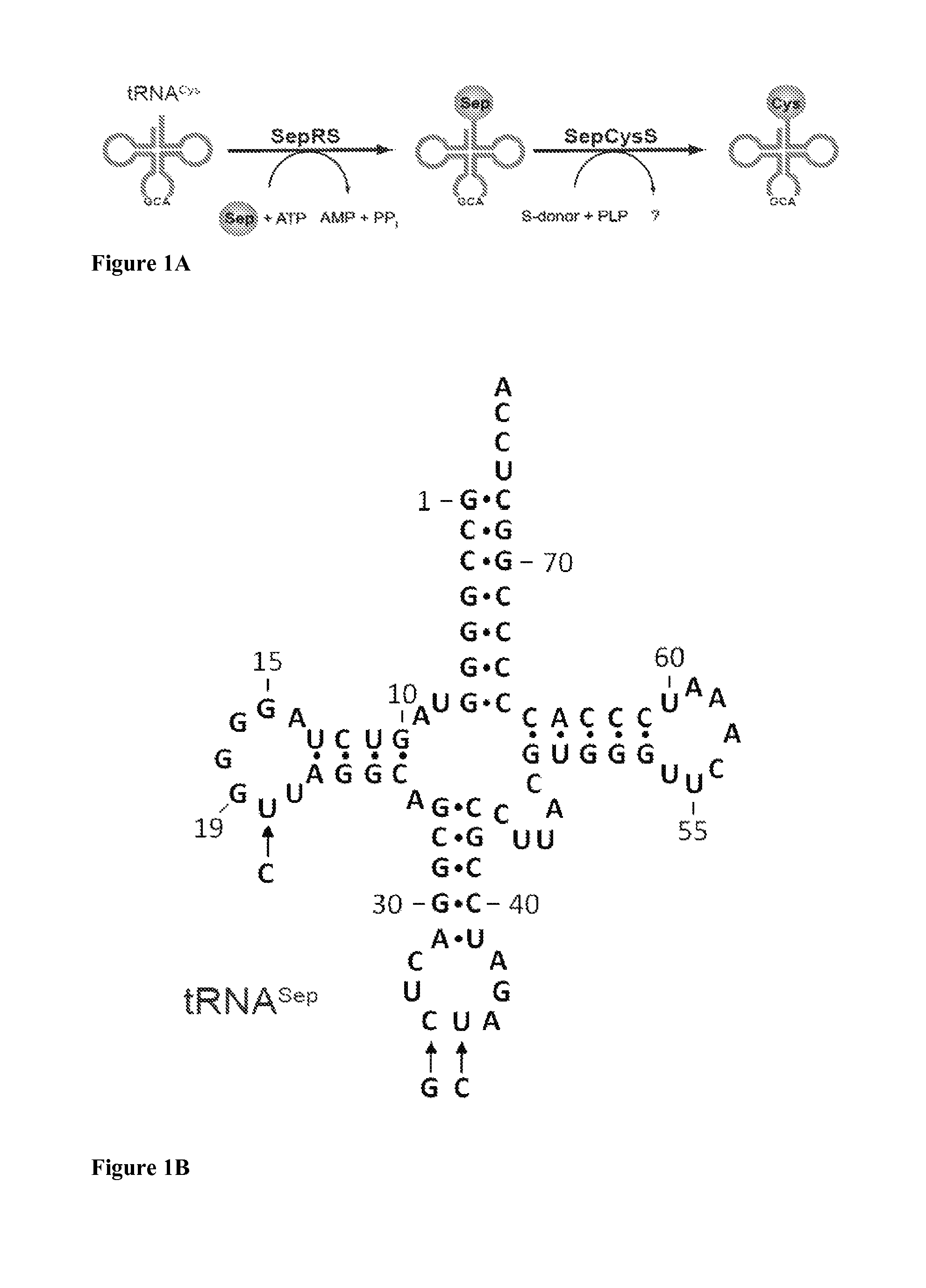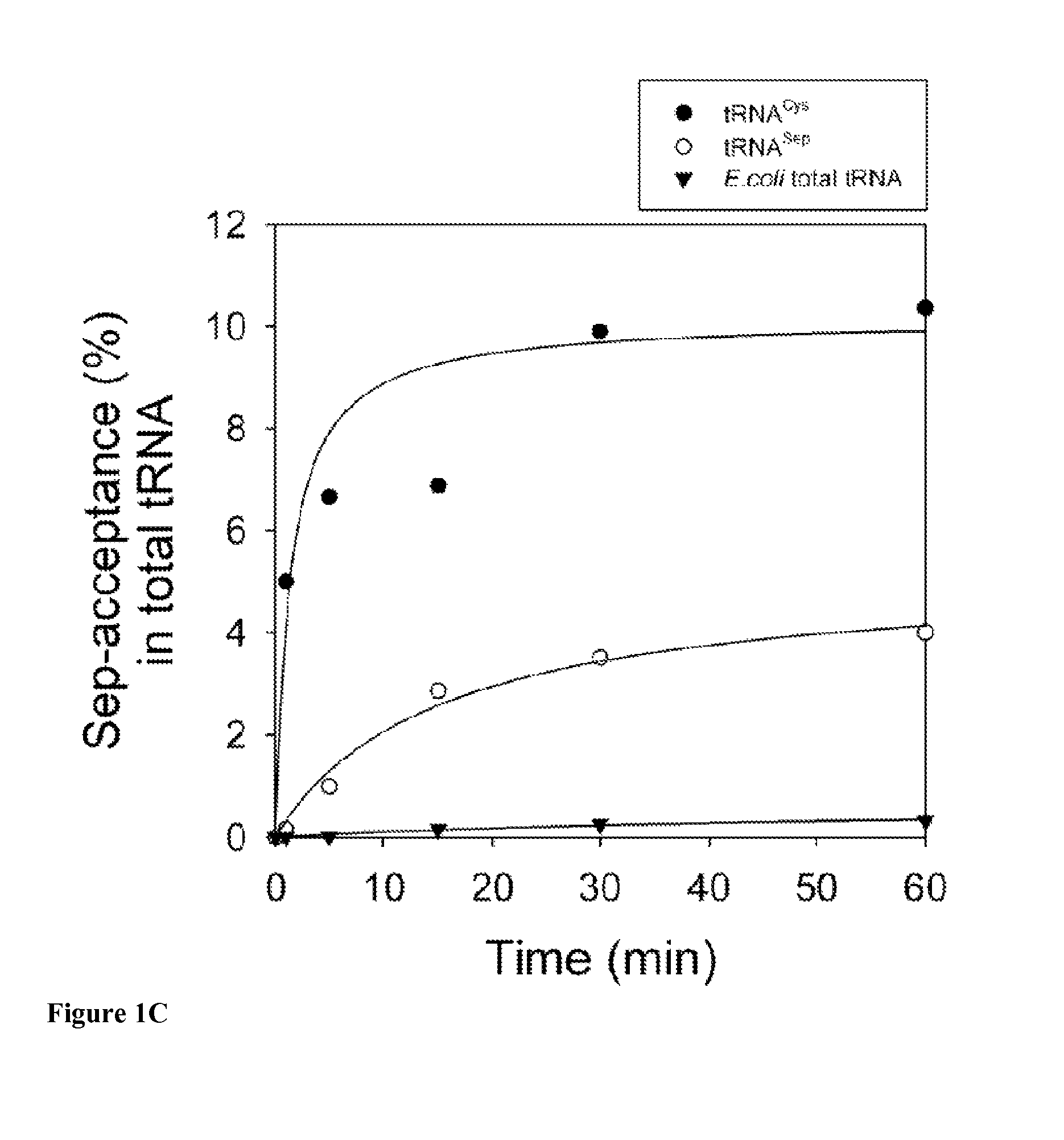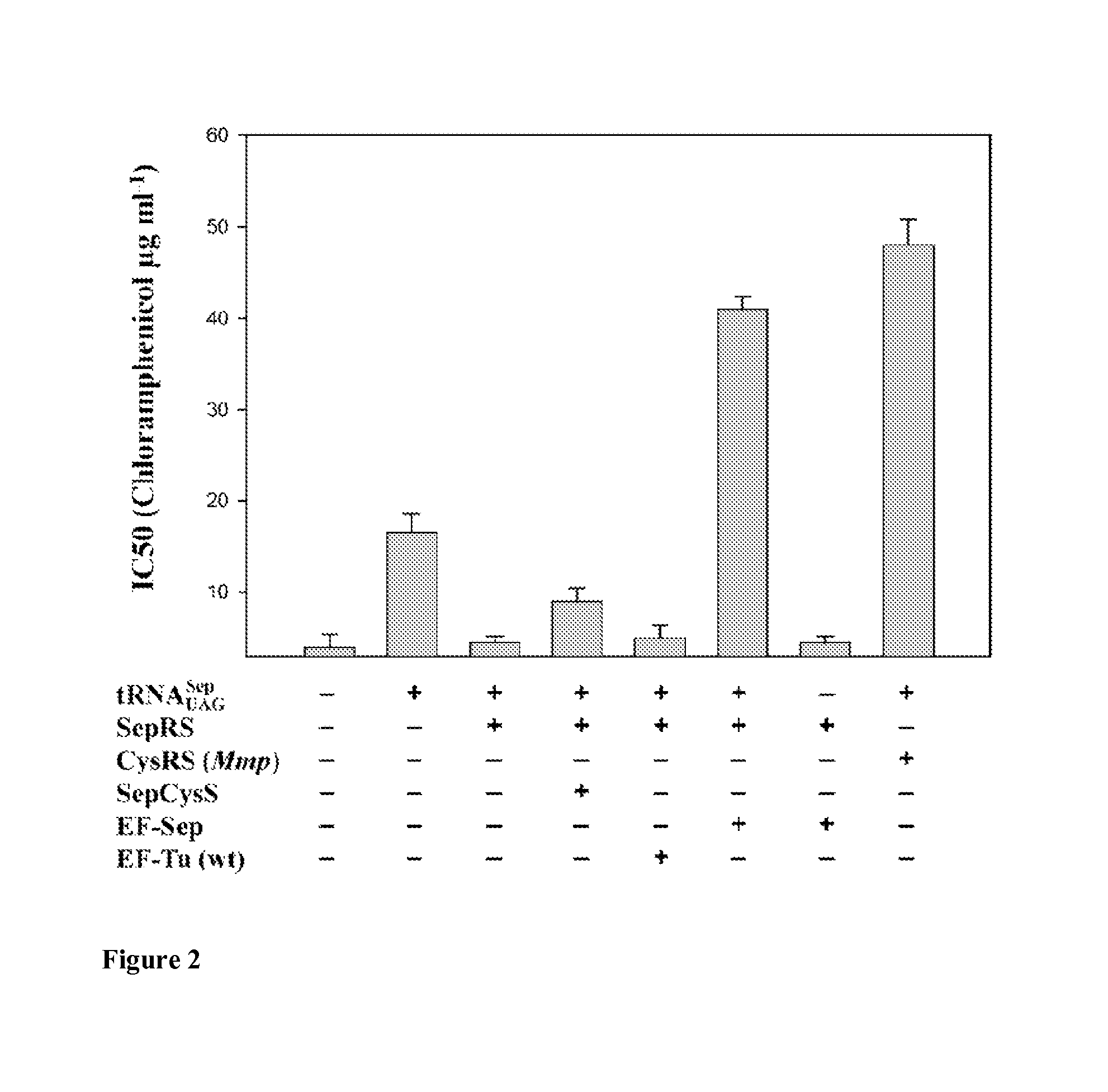Site-specific incorporation of phosphoserine into proteins in Escherichia coli
a phosphoserine and protein technology, applied in the field of site specific phosphorylation of proteins in vitro and in vivo, can solve the problems of large intracellular changes, increased or decreased activity of certain metabolic pathways, and difficult production of phosphoproteins
- Summary
- Abstract
- Description
- Claims
- Application Information
AI Technical Summary
Benefits of technology
Problems solved by technology
Method used
Image
Examples
example 1
SepRS and tRNASep are an Orthogonal Pair in E. coli
[0116]Materials and Methods
[0117]Constructions of Strains
[0118]To prevent possible enzymatic dephosphorylation of O-phospho-L-serine (Sep) in vivo, the gene encoding phosphoserine phosphatase (serB), which catalyzes the last step in serine biosynthesis, was deleted from Escherichia coli strains Top10 and BL21. Markerless gene deletions were carried out using a λ-red and FLP recombinase-based gene knockout strategy as described by Datsenko K A, et al. Proc Natl Acad Sci USA. 97:6640 (2000). E. coli strains Top10ΔserB and BL21ΔserB were used for EF-Tu library construction and MEK1 expression experiments.
[0119]Construction of Plasmids
[0120]To construct plasmid pSepT, the full-length gene encoding tRNASep was constructed from overlapping oligonucleotides and ligated immediately downstream of the lpp promoter in pTECH (Bunjun S, et al. Proc Natl Acad Sci USA. 97:12997 (2000)) using EcoRI and BamHI restriction sites. pCysT, encoding the ...
example 2
Development of EF-Sep
[0137]Materials and Methods
[0138]Library Construction and Selection of Sep-tRNA Specific EF-Tu
[0139]Six residues, His67, Asp216, Glu217, Phe219, Thr229, and Asn274, located in the amino acid binding pocket of the E. coli elongation factor EF-Tu were selected for randomization based on the crystal structure of the E. coli EF-Tu:Phe-tRNAPhe complex (protein data base accession number 1OB2). Multiple rounds of overlap PCR were carried out to incorporate random codons (NNK) at these positions by using the following primers described in Park H-S et al., Science 311:535-538 (2006):
[0140]
67XF,(SEQ ID NO: 19)5′-GT ATC ACC ATC AAC ACT TCT NNK GTT GAA TAC GACACC CCG-3′;H67R,(SEQ ID NO: 20)5′-AGA AGT GTT GAT GGT GAT AC-3′;216XF,(SEQ ID NO: 21)5′-CCG TTC CTG CTG CCG ATC NNK NNK GTA NNK TCCATC TCC GGT CGT GGT-3′;216R,(SEQ ID NO: 22)5′-GAT CGG CAG CAG GAA CGG-3′;229XF,(SEQ ID NO: 23)5′-GGT CGT GGT ACC GTT GTT NNK GGT CGT GTA GAACGC GG-3′;229R,(SEQ ID NO: 24)5′-AAC AAC GGT ACC...
example 3
Demonstration of Sep Incorporation into Myoglobin
[0159]Materials and Methods
[0160]Construction of Plasmids
[0161]pMYO127TAG-SepT was constructed by cloning a codon-optimized and C-terminally His6-tagged sperm whale myoglobin gene under the control of the lpp promoter between NotI and BglII in pSepT. An amber stop codon was introduced to the myoglobin gene at position Asp127 by quickchange mutagenesis. The nucleotide sequence of the codon-optimized myoglobin gene is as follows:
[0162]
(SEQ ID NO: 44)ATGGTTCTGTCTGAAGGTGAATGGCAGCTGGTTCTGCACGTTTGGGCTAAAGTTGAAGCTGACGTTGCTGGTCACGGTCAGGACATCCTGATCCGTCTGTTCAAATCTCACCCGGAAACCCTGGAAAAATTCGACCGTTTCAAACACCTGAAAACCGAAGCTGAAATGAAGGCTTCTGAAGACCTGAAAAAACACGGTGTTACCGTTCTGACCGCTCTGGGTGCTATCCTGAAGAAAAAGGGTCACCACGAAGCTGAACTGAAACCGCTGGCTCAGTCTCACGCTACCAAACACAAAATCCCGATCAAATACCTGGAGTTCATCTCTGAAGCTATCATCCACGTTCTGCACTCTCGTCATCCGGGTAACTTCGGTGCTGACGCTCAGGGTGCTATGAACAAAGCTCTGGAACTGTTCCGTAAAGACATCGCTGCTAAATACAAAGAACTGGGTTACCAGGGTGGTTCTGGTCATCACCATCACCATCACTAA.
[01...
PUM
| Property | Measurement | Unit |
|---|---|---|
| elongation factor | aaaaa | aaaaa |
| pH | aaaaa | aaaaa |
| concentration | aaaaa | aaaaa |
Abstract
Description
Claims
Application Information
 Login to View More
Login to View More - R&D
- Intellectual Property
- Life Sciences
- Materials
- Tech Scout
- Unparalleled Data Quality
- Higher Quality Content
- 60% Fewer Hallucinations
Browse by: Latest US Patents, China's latest patents, Technical Efficacy Thesaurus, Application Domain, Technology Topic, Popular Technical Reports.
© 2025 PatSnap. All rights reserved.Legal|Privacy policy|Modern Slavery Act Transparency Statement|Sitemap|About US| Contact US: help@patsnap.com



